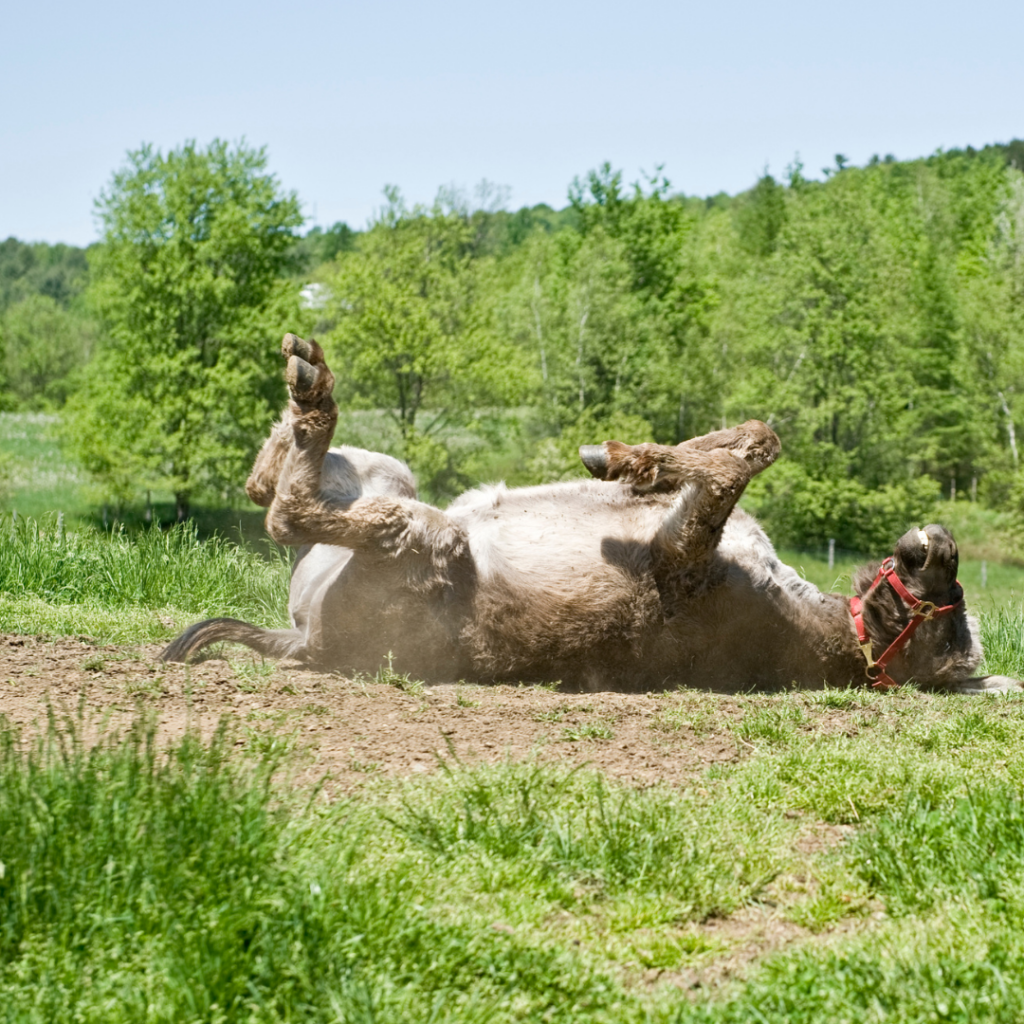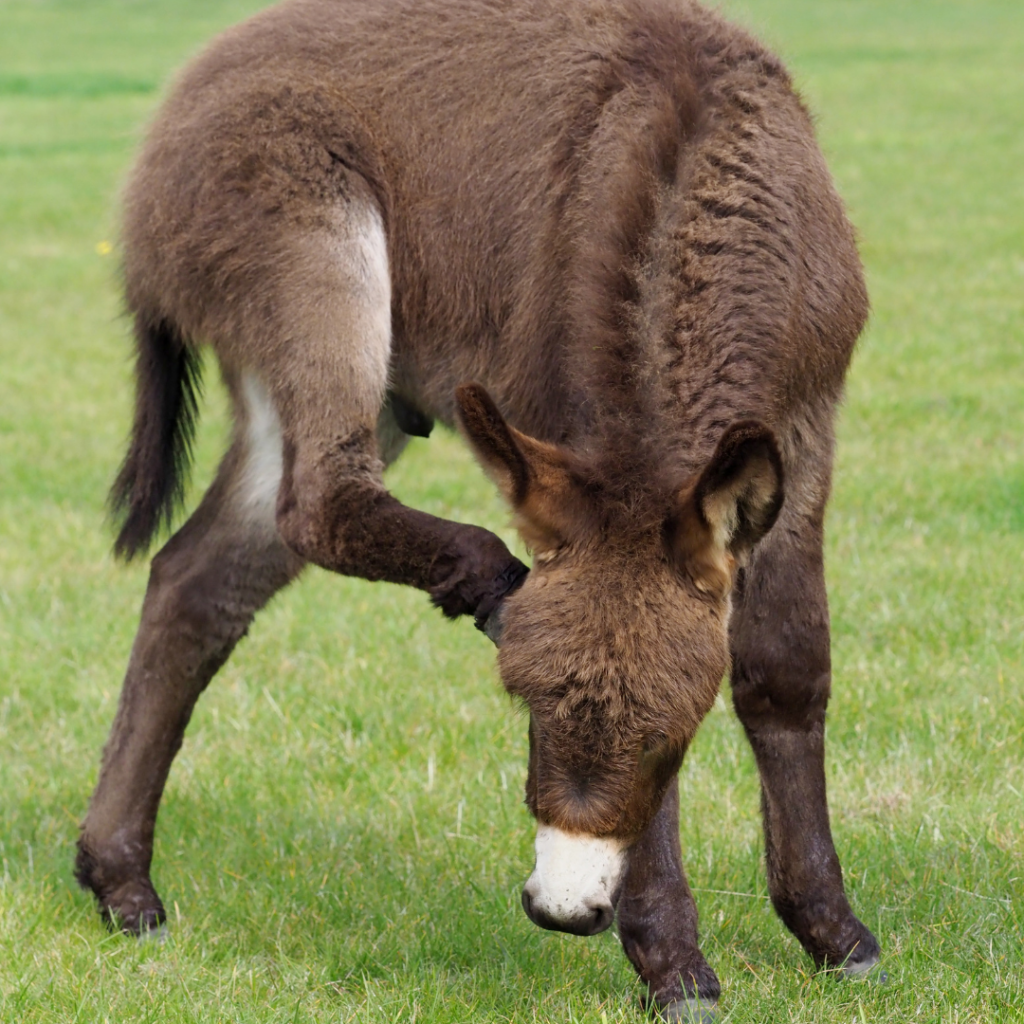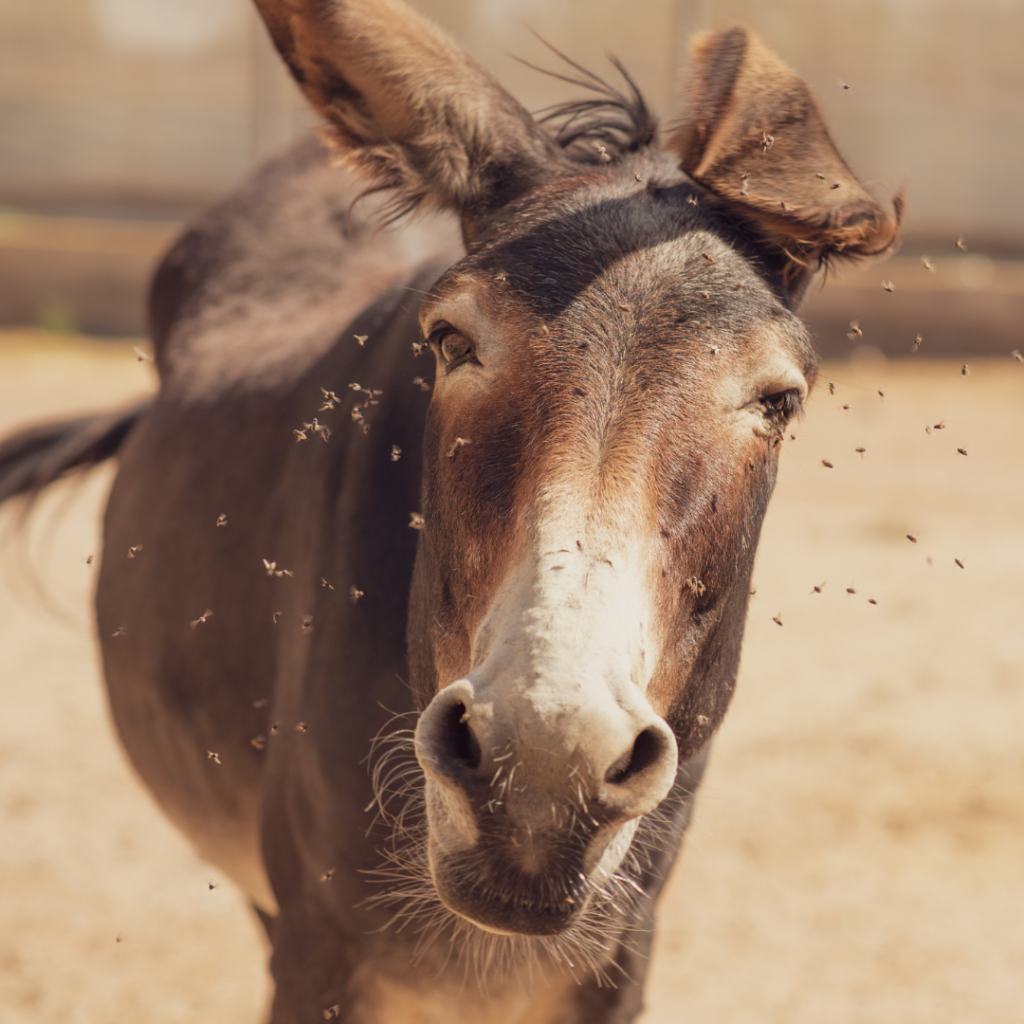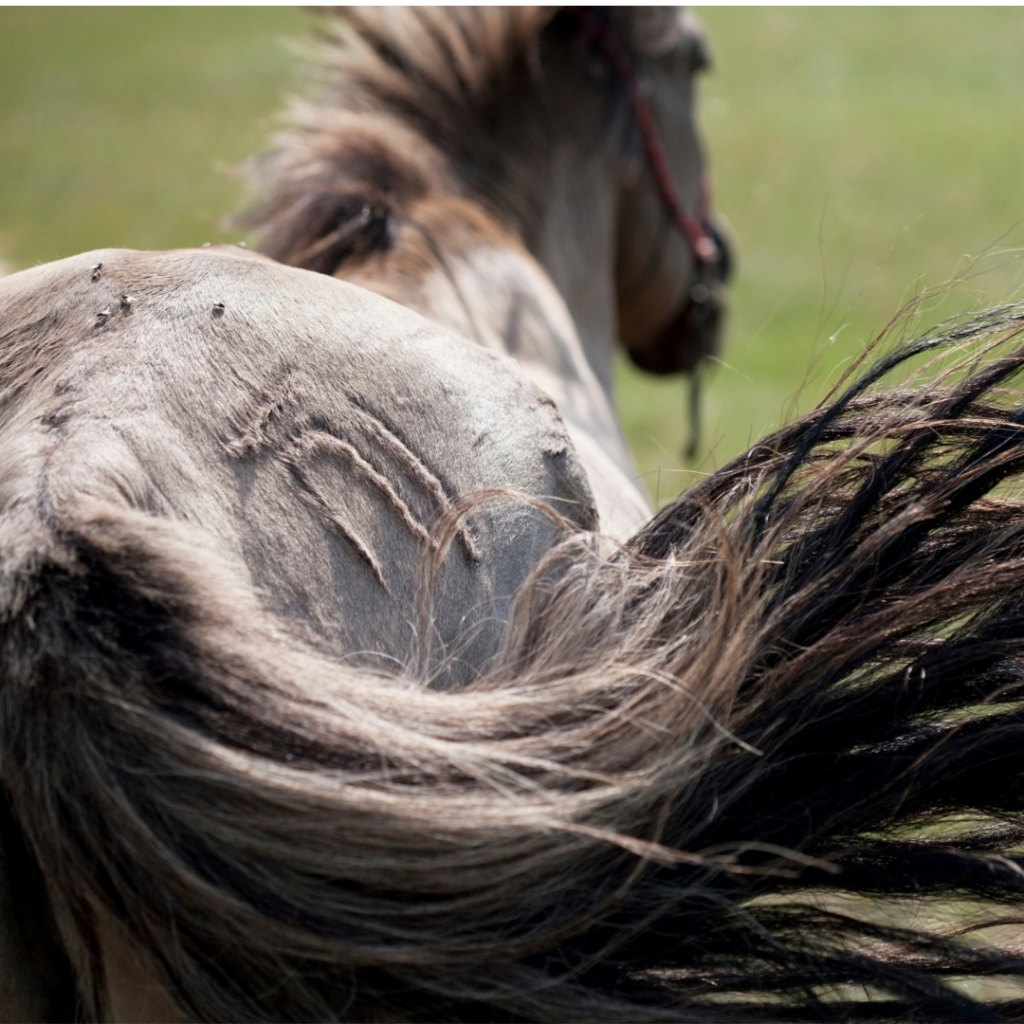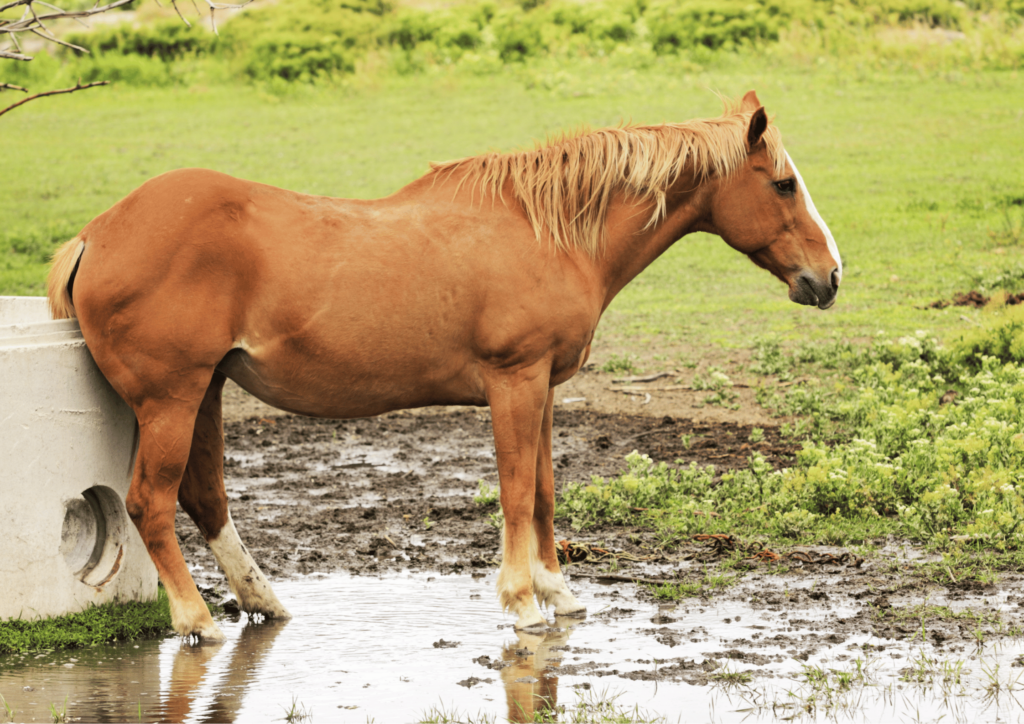

Veterinary Review Initiative
This resource has been reviewed for accuracy and clarity by a qualified Doctor of Veterinary Medicine with farmed animal sanctuaryAn animal sanctuary that primarily cares for rescued animals that were farmed by humans. experience as of October 2024.
Check out more information on our Veterinary Review Initiative here!
Depending on the climate in your area, you and your residents may live alongside a plethora of biting insects at certain times of the year or even year-round. While these insects are just doing what makes sense for them to do, it can prove downright miserable for residents and those who care for them. In this resource, we will focus on the condition referred to as “Sweet Itch”, which equine residents may experience if bitten by certain insects. As if being bitten isn’t uncomfortable enough, these bites can swell and itch for a prolonged period and even have serious health implications. This resource will define this condition, how to treat it, and look at some prevention tips to help equine residents at your sanctuary stay more comfortable. So just what is this condition? Let’s find out!
Sweet Itch Vocabulary
Because this resource introduces several clinical terms, we have added a brief definition of them below. Unless you have experience with this particular topic or a similar topic, some of these terms may be new to you. Understanding the clinical language for sweet itch can help facilitate better communication with your veterinarian.
- Pruritus: The clinical term for itching.
- Culicoides: The scientific term for a group of tiny, blood-feeding midges, around 1–3 mm in length.
- Immediate hypersensitivity (Type I): This is essentially the clinical term for an allergic reaction that happens within a short time (minutes) after exposure to the allergen. Some humans experience this with latex or mosquito bites, for example.
- Delayed hypersensitivity (Type IV): This is the clinical term for an allergic reaction that generally occurs 48-72 hours after continued exposure or reexposure to the allergen (e.g. poison ivy).
- Secondary Infections: Secondary infections are those that occur after a primary infection or illness. In the case of sweet itch, a secondary infection usually occurs due to the scratching of the itch, creating open wounds in the skin.
- Intradermal: This means within the skin, specifically the area under the very top layer of the skin (the epidermis) called the dermis.
What Is “Sweet Itch”?
Sweet Itch is a type of skin hypersensitivity affecting horses, ponies, and donkeys. Essentially, affected equines have an allergic reaction when bitten. This reaction can range from mild symptoms that cause itching and discomfort, passing within a couple of days, to serious chronic symptoms including prolonged itching, weight loss, and secondary infections. The psychological toll is hefty. Most of us have experienced a bout of intense itching that lasted some time, we can surely relate!
While bites from mosquitoes, blackflies, horseflies, and mites can certainly cause insect bite hypersensitivity, biting midges (small flies) in the culicoides genera are most commonly the cause of “sweet itch”. Sweet itch may also be referred to as summer itch, recurrent seasonal pruritus, Queensland itch, or other regional terms. The clinical term is “Culicoides hypersensitivity”. The saliva of the midges can cause localized allergic reactions in some individuals, resulting in extreme itchiness and discomfort. Most reactions are an immediate hypersensitivity (Type I) but can also include a delayed hypersensitivity reaction (Type IV).
Sweet itch generally affects equines when the climate is warmer, with wet, warm climates seeing a large population of midges, among other biting insects. For some sanctuaries sweet itch may be a seasonal occurrence, but for those of you in warmer climates, it can be a year-round issue for equine residents. There may be a hereditary component as it appears a horse who has a parent with sweet itch is more likely to develop it themselves. There are also particular breeds of horses who are more prone to sweet itch. These include Icelandic horses, Fresians, Arabians, Welsh, and Shetland ponies among others.
Signs Of Sweet Itch
Now that you have a better idea of what sweet itch is and how it is caused, let’s look at some of the signs and symptoms. The following symptoms can also indicate other health conditions, so the affected resident must be properly diagnosed by your veterinarian.
Physical Signs
- Hair loss in localized areas
- Rough or mussed coat
- Scaly, rough skin
- Thickened skin
- Hives
- Rat tail or “Toilet-brush tail”
- Localized heat
- Inflamed, reddened skin (noticeable on some horses with lighter coats)
- Weight loss in severe cases
Behavioral Indicators
In addition to physical symptoms, there are behavioral indicators that can tip you off that something is amiss and a resident requires a health check. If you notice sudden changes in behavior, it is always important to investigate to determine the cause of these behavioral changes. Early detection of sweet itch and other conditions allows for earlier treatment and less discomfort for the resident overall.
- Rubbing their rump or neck on fences or other objects more frequently than usual, or for an extended length of time
- Biting at whatever body parts they can reach
- Acting restless, agitated, or unable to settle
- Rolling excessively
- Head shaking
- Vigorous tail switching
- Eating less food
- Overall change in personality
Prevention Tips
Sweet Itch Vaccination
A vaccination originally developed to prevent ringworm has been used to help diminish symptoms of sweet itch in equines. This vaccine consists of 2 injections, 2 weeks apart. It takes 5 weeks before it is fully effective and should be given before the start of any seasonal change hospitable to insect populations. Talk to your veterinarian about the best options for your equine residents.
When it comes to sweet itch, the hope is to prevent residents from being bitten by midges and other insects in the first place. Although this can feel like a losing battle, caregivers can take a number of preventative steps to lower the risk of sweet itch in resident populations.
- Relocation: If equine residents are currently living in a space that has standing water or muddy conditions but you have another drier paddock or pasture, move them to this area. Insects are likely to be more prevalent in damp, muddy areas. Additionally, breezy areas generally have fewer midges as the wind disperses them.
- Physical Barrier: Use fly sheets or specialized sweet itch rugs and masks (may be called hoods in some areas) to protect the resident’s skin from bites. Be sure to have two sheets/rugs so they can wear one while the other is cleaned. You can rub special ointments and salves on a resident’s skin to create enough of a barrier to protect them from the bites of midges and other insects.
- Timing: Midges are often especially active at dawn and early evening. If you are able, take extra precautions to avoid exposure to midges during this time.
- Repellant: There are a number of insect repellents on the market for equines. The main ingredients vary, from pyrethroid and permethrin, to DEET and sprays containing more natural ingredients such as neem oil.
- Cleanliness: Clean and muck living areas frequently, removing soiled bedding, feces, and leftover food all of which may attract midges. Place compost piles away from resident living areas.
- Indoor Protections: There are several ways you can help keep their indoor areas protected. Use mesh netting in entryways such as doors and windows. This may alarm some residents so be slow and careful to introduce them to it. Set up a fan to make it more difficult for midges to stay in one place.
If you implement the above tactics, they should help reduce a resident’s exposure to midges. This, in turn, decreases the overall risk of someone developing sweet itch. Unfortunately, nothing is foolproof and some residents may be especially sensitive to bites. These individuals will require quick diagnosis and implementation of a treatment and management plan created by your veterinarian. Other health issues can mimic some of the signs of sweet itch. It is important to have your veterinarian diagnose a resident to ensure they receive the appropriate treatment. Let’s discuss getting a diagnosis!
Diagnosis
Early diagnosis is important so treatment can begin promptly. The longer sweet itch goes undiagnosed the harder it can be to manage. The risk of secondary infections increases the longer it goes untreated. This is due to the sores caused when residents scratch, rub, or even bite themselves repeatedly to scratch the itch and obtain relief. While comprehensive health checks are not practical daily, each resident should be briefly observed to check for signs of injury or illness.
If you notice a resident rubbing their rump or neck or other part of their anatomy on fences or other objects at an unusual frequency or length of time, investigate! If sweet itch is suspected, contact your veterinarian and request a health examination for the resident. They will likely ask about any behaviors you may have noticed, such as those listed above, and do a physical exam to look for common signs and other indications of illness or injury.
Diagnosis generally occurs by the observance of common symptoms and consideration of the climate and other environmental factors. However, your veterinarian may decide to do an intradermal allergy test to make a diagnosis. Since this test is similar to allergy testing in humans, you may have even experienced something like it yourself! For those of you who are unfamiliar, an intradermal allergy test involves taking extracts of suspected allergens and injecting a small amount under the skin. Once the allergen has been injected, you observe for any signs of a reaction. In the case of sweet itch, a veterinarian would take culicoides midge extract and inject it under the equine resident’s skin and look for signs of hives or irritation. If one of your equine residents is diagnosed with sweet itch, your veterinarian will provide a treatment plan.
Treatment & Management
Unfortunately, there is no cure for sweet itch. However, some individuals who are diagnosed have mild cases that resolve once management techniques (see prevention section) that reduce exposure to midges are set in place. Without these environmental adjustments, afflicted residents will be continuously exposed, potentially exacerbating symptoms and making treatment more difficult. Those with a greater sensitivity to midge bites will generally require specialized treatment in addition to environmental adjustments. Depending on the severity of the sweet itch, a veterinarian may recommend one, some, or all of the following as a course of treatment.
- Cool water
- Anti-itch, skin-calming shampoos
- Anti-itch creams
- Antihistamines
- Antibiotic ointment, pills, or injections
- Steroidal creams, pills, or injections (Note that long-term steroid use is generally not recommended due to the increased risk of laminitis)
- If there is a secondary infection, there are antibiotic ointments that may be recommended, however, sometimes tablets and/or injections are needed
- Various dietary supplements and herbs have been touted to be helpful for sweet itch but the data on this varies, depending on the type of supplement. We recommend discussing supplements with nicotinamide as a key ingredient with your veterinarian
Speak with your veterinarian about the care plan that best fits the needs of your residents. There are other factors to consider when medicating a resident and doing so without the oversight of an experienced veterinarian can result in serious harmThe infliction of mental, emotional, and/or physical pain, suffering, or loss. Harm can occur intentionally or unintentionally and directly or indirectly. Someone can intentionally cause direct harm (e.g., punitively cutting a sheep's skin while shearing them) or unintentionally cause direct harm (e.g., your hand slips while shearing a sheep, causing an accidental wound on their skin). Likewise, someone can intentionally cause indirect harm (e.g., selling socks made from a sanctuary resident's wool and encouraging folks who purchase them to buy more products made from the wool of farmed sheep) or unintentionally cause indirect harm (e.g., selling socks made from a sanctuary resident's wool, which inadvertently perpetuates the idea that it is ok to commodify sheep for their wool). to your resident if they have other health conditions.
We hope you and your care team found this resource informative! We know keeping residents healthy and happy is your priority. Learning about common health conditions, such as sweet itch, in equine populations can help you provide the best care when issues arise. In addition to sweet itch, warm weather can come with unique challenges for residents and caregivers. If you haven’t yet, we’d recommend checking out our “Summer And Hot Weather Considerations For Animal Sanctuaries” resource.
SOURCES:
Sweet Itch and Other Summer Allergies | The Dick Vet Equine Practice
Sweet Itch | World Horse Welfare
Sweet Itch | Bell Equine Veterinary Clinic
Sweet Itch | Corner House Equine Clinic







